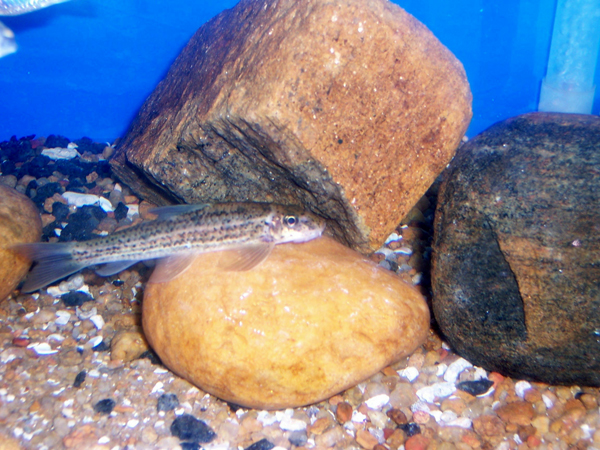Thirty percent of the fish exported from India in the past seven years were from dozens of threatened species including the endangered red-lined torpedo barb (Puntius denisonii) and the miss kerala look alike (Puntius chalakkudiensis) amongst others, according to a recently published paper in Biological Conservation. By documenting the extent and impact of the trade in rare and threatened freshwater fish species in India, scientists have uncovered the local scale of the aquarium pet trade.
India is home to a diverse range of freshwater fish, including a large number of endemic species, i.e. species found no-where else. But the report focuses on the fish trade from two biodiversity hotspots in India, Eastern Himalaya and Western Ghats, both of which are known for their biodiversity. To date the collections of freshwater fish is “open access, unregulated and even encouraged by certain governmental and semi-governmental agencies” according to the paper.
The aquarium pet trade is worth around $15-30 billion globally and is fueled by the increased demand from the hobbyists in countries like Europe and America. While it is reported that 90% of freshwater fish in the trade are captive bred, a large number of wild fish are being exported from India.

Carinotetraodon imitator – IUCN Red List Status – Vulnerable. Photo by Rajeev Raghavan.
“More than 1.5 million freshwater fish belonging to 30 threatened species were exported from India during the last seven years,” explains Rajeev Raghavan, Neelesh Dahanukar and Sanjay Molur co-authors of the paper. Among these species include those “which local regulations on collection and export were in place (e.g., red-lined torpedo barb); species with small distribution range including being restricted to a single location (e.g., Orange-spotted Snakehead Channa aurantimaculata); and species found only in protected areas (e.g., Devi’s Loach Mesonoemacheilus remadevii)”
Species such as the red lined torpedo barbs have shown a dramatic decline in population numbers in the past two decades leading to being listed as Endangered on the IUCN Red List. The listing led authorities to put in place restrictions on collection and exportation. However, due to the lack of data and knowledge on the biology of the species it has made very little impact. This is often the case for many of the fish species within the trade in India, according to the researchers.
Globally threatened species such as Red Canarese Barb (Gonoproktopterus thomassi) (Critically Endangered), Glyptothorax housei (Endangered) and the Malabar Hatchet Chela (Laubuca fasciata) (Vulnerable) were also exported.

Garra surendranathanii – IUCN Red List Status – Endangered. Photo by Rajeev Raghavan.
The shocking discovery of so many rare and threatened species is a clear indication that the trade is largely unregulated.
One major problem identified by the paper is the generic labeling of fish as “live aquarium fish” and not by specific species when exported. Four of the threatened species identified by the study did not show up on export data yet were identified in the study through import data. Species specific labeling is not a legal requirement in India.
The paper suggests using an organized coding system which should include “species name, capture locations, size of the specimens, and the names collector and exporter.” However, they add “mere collection of [this] data [is] not sufficient to assure the harvest of ornamental fish [is] conducted in a manner that does not lead to further decline in wild species abundance.”
Raghavan, Dahanukar and Molur identify a number of steps to help protect and prevent the extinctions of freshwater fish species including “strengthening the enforcement of inland fisheries laws and acts in various states of the country, developing and implementing freshwater protected areas and fish refugee, framing policies with regard to the collection and export of endemic and threatened freshwater fishes for the pet trade and recognizing fish as an important group of wildlife for conservation rather than just a commodity for exploitation.”
If India wants to hold on to their freshwater fish biodiversity they should move towards a more sustainable trade and move away from using threatened species, according to the researchers. Educating the hobbyists and importers with information on the conservation status of fish species could help lower the demand and prevent the collection of threatened fish.
The trade in fish for aquariums is not likely to stop completely. However, the scientists argue that if the trade was well managed it could provide livelihood opportunities for local communities in rural and remote areas while protecting the diversity in freshwater fish in India.

Horabagrus brachysoma – IUCN Red List Status – Vulnerable. Photo by Rajeev Raghavan.

Channa diplogramma – IUCN Red List Status – Vulnerable. Photo by Rajeev Raghavan.
CITATION: Rajeev Raghavan, Neelesh Dahanukar, Michael F. Tlusty, Andrew L. Rhyne, K. Krishna Kumar, Sanjay Molur, Alison M. Rosser, Uncovering an obscure trade: Threatened freshwater fishes and the aquarium pet markets, Biological Conservation, Volume 164, August 2013, Pages 158-169
Related articles
Zoos call on governments to take urgent action against illegal wildlife trade (photos)

(07/24/2013) In a single night in March, a band of heavily-armed, horse-riding poachers slaughtered 89 elephants in southern Chad, thirty of which were pregnant females. The carnage was the worst poaching incident of the year, but even this slaughter paled in comparison to the 300 elephants killed in a Cameroon park in 2012. Elephant poaching is hitting new records as experts say some 30,000 elephants are being killed every year for their ivory tusks. But the illegal wildlife trade—estimated at $19 billion—is not just decimating elephants, but also rhinos, big cats, great apes, and thousands of lesser-known species like pangolins and slow lorises. This growing carnage recently led to representatives of over 40 zoos and dozens of wildlife programs to call on governments around the world to take immediate action on long-neglected wildlife crime.
Featured video: saving animals from the illegal pet trade in Guatemala
(07/22/2013) Found in Central America’s largest forest, the Maya Biosphere Reserve, the Guatemalan organization Arcas has rescued and rehabilitated thousands of animals since its inception in 1989. Unlike many wildlife rescue centers worldwide, Arcas focuses on rehabilitating every animal for eventually release back into the wild. This means intensive training for each species, including food gathering and predator avoidance. A new short video by Arcas highlights the group’s decades-long work.
Illegal wildlife trade flourishes in Sumatra

(06/10/2013) In a chilly rain on Sunday, in a town just a few kilometers beyond the edge of a protected Sumatran rainforest, a young orangutan sat perched on a piece of plywood and grabbed the metal wires of his tiny cage.
He has sat in that cage for six months and, like dozens of other species on display in this ‘zoo’ in the town of Kadang in Aceh, he has a price tag. This packed assembly is an acknowledged front for illegal trafficking in wildlife.
Loris champion: conserving the world’s most surprising primate family

(06/04/2013) Before Anna Nekaris began championing the cause of the world’s lorises, little was known about this cryptic family of large-eyed, nocturnal, insect-eating, venomous primates. Nekaris, with Oxford Brookes University and founder of the Little Fireface project, has been instrumental in documenting rarely-seen loris behavior, establishing conservation programs, and identifying new species of these hugely-imperiled Asian primates.
Monitor lizards vanishing to international trade in pets and skins

(06/04/2013) The world’s monitor lizards remind us that the world was once ruled by reptiles: this genus (Varanus) includes the world’s biggest lizards, such as the stunning Komodo dragon and many other island kings. A large number beautifully-colored and patterned, these lizards are known for their intelligence and their apex role in many island food chains. However, a new study finds that the world’s monitors, especially those in Southeast Asia, are vanishing due to the international pet trade and for their skins, which are turned into handbags and straps for watches. Meanwhile the rapid destruction of their rainforest homes is exacerbating the situation.